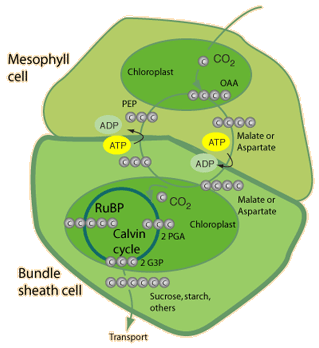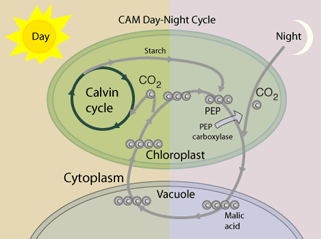 Daily Newsletter
Daily Newsletter
October 12, 2012
C4 and CAM Plants
As mentioned before, photorespiration is a problem for plants. Instead of adding CO2 to Ribulose 1,5-Bisphosphate, O2 is added. The equation is:
RuBP + O2 → Phosphoglycolate + 3-phosphoglycerate + 2H+
What we wanted was two 3PG, not one. This means we will have difficulty recovering RUBP. RuBisCo is still the enzyme that catalyzes this reaction. The enzyme normally uses CO2, but if there is a high concentration of O2, RuBisCo will add oxygen.
For most plants, this is not a big problem, but it can be a major problem for some fast growing plants or those in dry environments. There are two evolutionary adapations that are present in some plants to help them avoid photorespiration. In both cases, the adaptation deals with the carbon fixation step (we are going to isolate RuBisCo from Oxygen).

C4 plants spatially isolate RuBisCo from gas exchange occuring in a plant's leaf. All cells have to experience gas exchange, and in plants there are air filled spaces between cells. Plants have specialized structures known as Stomata that allow them to exchange gases within the leaf with atmospheric gasses. The problem with atmospheric gas is that there is more Oxygen than Carbon Dioxide. C4 plants have cells that are specialized in the Calvin Cycle. These specialized Calvin Cycle cells(Bundle Sheath Cells) are protected from gas exchange with atmospheric gasses by the Mesophyll Cells. The Mesophyll Cells can bind CO2 to PEP (Phosphenolpyrvate) to form a 4 carbon structure (hence the name C4). This is either Malate or Aspartate, which then enters the Bundle Sheath Cells. In the Bundle Sheath, it releases CO2 when is then used in the Calvin Cycle. By binding CO2 in the Mesophyll Cell, you can build up a concentration of CO2 in the Bundle Sheath Cell. In this way, photorespiration is prevented.
CAM (Crassulacean Acid Metabolism) plants have a temporal seperation.
 During the day, they keep their stomata closed to prevent moisture loss, but at night they open their stomata for gas exchange. At night, the cells bind CO2 to PEP, making Malic Acid. It store Malic Acid, and then during the day converts Malic acid back into PEP and CO2. It is during the day that we get the power for the Calvin Cycle, so we store CO2 in Malic Acid until we can get the energy for the Calvin Cycle.
During the day, they keep their stomata closed to prevent moisture loss, but at night they open their stomata for gas exchange. At night, the cells bind CO2 to PEP, making Malic Acid. It store Malic Acid, and then during the day converts Malic acid back into PEP and CO2. It is during the day that we get the power for the Calvin Cycle, so we store CO2 in Malic Acid until we can get the energy for the Calvin Cycle.Daily Challenge
In your own words, describe the C4 and CAM adaptations to the Calvin Cycle. Include in your discussion the evolutionary significance of these modifications.Link to Forum
No comments:
Post a Comment